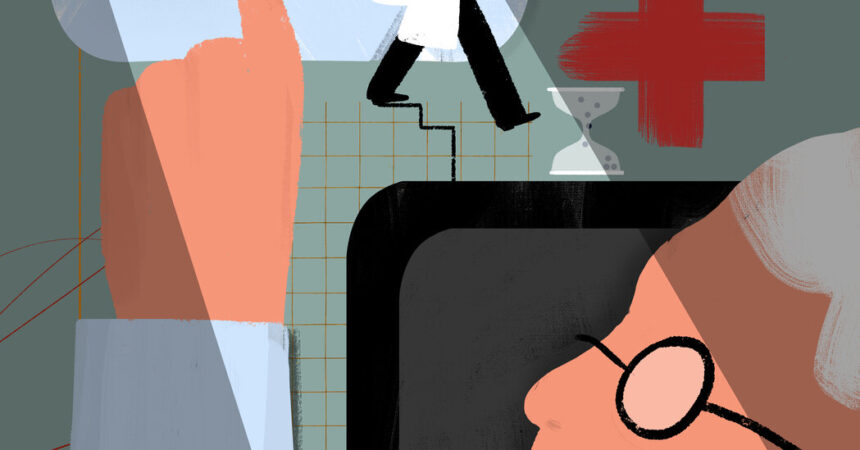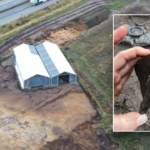Since his most cancers prognosis final yr, Kent Manuel has often seen an oncologist close to his house in Indianapolis. It’s been a tricky time: After spinal surgical procedure for paralysis attributable to his most cancers, he’s regaining using his legs with bodily remedy however nonetheless makes use of a wheelchair.
Now, Mr. Manuel stated, “I’m coping with ache.” His oncologist really useful palliative care, a medical specialty that helps folks with critical sicknesses address discomfort and misery and keep high quality of life.
So in November, Mr. Manuel, 72, a semiretired accountant, began seeing Dr. Julia Frydman, a palliative care physician. “We discuss by what works and what doesn’t,” he stated. “She listens to what I’ve to say. She’s very versatile.”
The primary two medicines she prescribed to cut back ache had troublesome uncomfortable side effects. On the third attempt, although, “I feel we’ve landed on one thing that’s working,” he stated. His ache hasn’t totally abated, nevertheless it has diminished.
Dr. Frydman, the senior medical director at a most cancers care expertise firm referred to as Thyme Care, works lots of of miles away in a Manhattan workplace. She and Mr. Manuel used a video telemedicine hyperlink — an possibility that hardly existed in conventional Medicare earlier than the Covid pandemic, due to restrictive federal insurance policies.
Medicare expanded its telemedicine protection considerably in 2020, and the growth has often been renewed. That might all have ended on Dec. 31.
Supporters of telemedicine, additionally referred to as telehealth, endured some nail-biting days as Congress thought of a seamless decision to fund the federal government previous yr’s finish. Included within the 1,500-page invoice was a two-year extension for expanded Medicare protection for telemedicine.
Republicans had agreed to the decision, however modified their minds after Elon Musk and Donald Trump condemned it. “That killed the invoice,” stated Kyle Zebley, senior vp for public coverage on the American Telemedicine Affiliation.
Lastly, Congress accredited a narrower model, a three-month extension. So telemedicine lives, at the least till March 31.
Mr. Zebley, who estimates that 20 to 30 % of medical encounters might happen nearly, expects additional renewal. Telemedicine is “so common and so bipartisan in nature I can’t think about the Trump administration and Congress permitting it to lapse,” he stated.
Tricia Neuman, who directs the Medicare coverage program at KFF, the nonprofit well being coverage analysis group, agreed. “Telehealth protection seems to be right here to remain as an possibility for Medicare sufferers,” she stated in an electronic mail.
Its use has declined for the reason that early pandemic. When sufferers had been afraid to maintain medical appointments and lots of practices closed their workplaces, Medicare started overlaying at-home video and audio visits for extra sorts of suppliers and lots of extra circumstances.
Virtually immediately, telemedicine use soared. In 2020, virtually half of Medicare beneficiaries had at the least one such go to. By late final yr, that proportion had receded to about 13 %.
That also represents far larger use than in early 2020, when about 7 % of beneficiaries had digital visits.
Although telehealth works higher for some providers than others, “some sufferers have come to depend on it,” Dr. Neuman stated.
Take palliative care, which isn’t broadly obtainable all over the place. Indiana, for instance, obtained a not-great 2.5-star score for palliative care capability on the Heart to Advance Palliative Care’s state scorecard.
Telemedicine might help fill the hole. “Working intently with oncologists who see them in particular person,” Dr. Frydman stated, “we’re capable of take excellent care of sufferers with superior most cancers and get them entry.”
Even when Mr. Manuel had been capable of shortly prepare an appointment with an area palliative care physician, “I’m disabled, so journey is a trouble,” he stated.
A short in-person session can require two arduous hours of getting right into a automobile (a caregiver drives him), securing a wheelchair after which unloading it, coming into a medical facility, ready, after which reversing the method.
As an alternative, “it’s very good to sit down in my house and maintain a cellphone in entrance of my face and simply discuss,” he stated.
Different sufferers described an identical hybrid method. Jim Seegert, 74, a retired graphic designer in Hopewell Junction, N.Y., sees his main care physician in particular person 4 occasions a yr to handle diabetes, hypertension and excessive ldl cholesterol.
“I’m a face-to-face sort of particular person,” he defined. In addition to, he wants blood exams, and “there are issues that may’t be achieved on the web.”
However to debate the outcomes, he schedules a digital go to, normally by cellphone. “I’m comfortable to have the choice,” he stated.
Bruce Lerner estimated that he had 10 telehealth visits in 2024. “I had a tough yr,” stated Mr. Lerner, 67, a lawyer in Washington, D.C. “I had Covid. I had shingles. I had pneumonia.”
Generally his clinicians at One Medical, the Amazon-owned main care observe, informed him to return to an workplace or get a chest X-ray at a radiology clinic.
About half the time, although, they listened, suggested and prescribed nearly. “It not solely reduces pointless workplace visits, nevertheless it most likely additionally reduces E.R. visits,” Mr. Lerner stated.
Helen Epstein, 77, of Lexington, Mass., has wearied of driving an hour by site visitors to and from Massachusetts Common Hospital. Her medical visits piled up over the previous few years as Ms. Epstein, a author, was efficiently handled for uterine most cancers, recovered from a stroke and contended with atrial fibrillation.
So on the subject of consulting her main care physician, she’s comfortable to schedule video visits. “As a result of she’d been my doctor for a very long time, it was a very simple transition,” Ms. Epstein stated.
Her husband credit telemedicine with sparing him an emergency room journey after a pal’s canine bit his leg. On video, their physician might see the injuries and decided that house remedy would suffice.
Partially as a result of a lot of the analysis on telemedicine was undertaken through the early pandemic, an irregular interval, questions persist about its prices and effectiveness.
An early examine of about 200 older sufferers utilizing telemedicine, as an example, discovered basic satisfaction. But virtually 40 % stated it was worse than in-person visits, and a few discovered the expertise irritating.
Which may be much less true three years later, however “the first barrier continues to be expertise,” Dr. Frydman stated. Some suppliers now ship sufferers hyperlinks in order that they don’t want to recollect logins and passwords, and rent workers to assist them join.
One other early examine, utilizing Medicare claims knowledge, reported that telehealth was related to barely extra hospitalizations and encounters with clinicians, in addition to with modestly increased per-patient prices. However that would replicate larger hospital capability in areas with excessive telehealth use through the pandemic, the authors cautioned, not essentially lower-quality care.
However, one other investigation additionally discovered elevated affected person visits and prices in well being programs with larger telemedicine use, however no change in hospitalization and decrease emergency division use.
Extra lately, a medical trial involving sufferers with superior lung most cancers (common age: 65) discovered equal satisfaction and quality-of-life scores amongst those that obtained palliative care by video visits and people who obtained it in particular person.
“The info are actually clouded as a result of we had been nonetheless taking a look at proof from the general public well being emergency,” Dr. Frydman stated. Now, she added, “we’d profit from extra research of outcomes.”
Mr. Manuel, for one, has grow to be a believer. He finds telemedicine “immensely extra environment friendly,” he stated, and “it widens the group of execs I can seek the advice of with.”
“I’ll elect telemedicine over an in-person go to each time it’s obtainable.”








